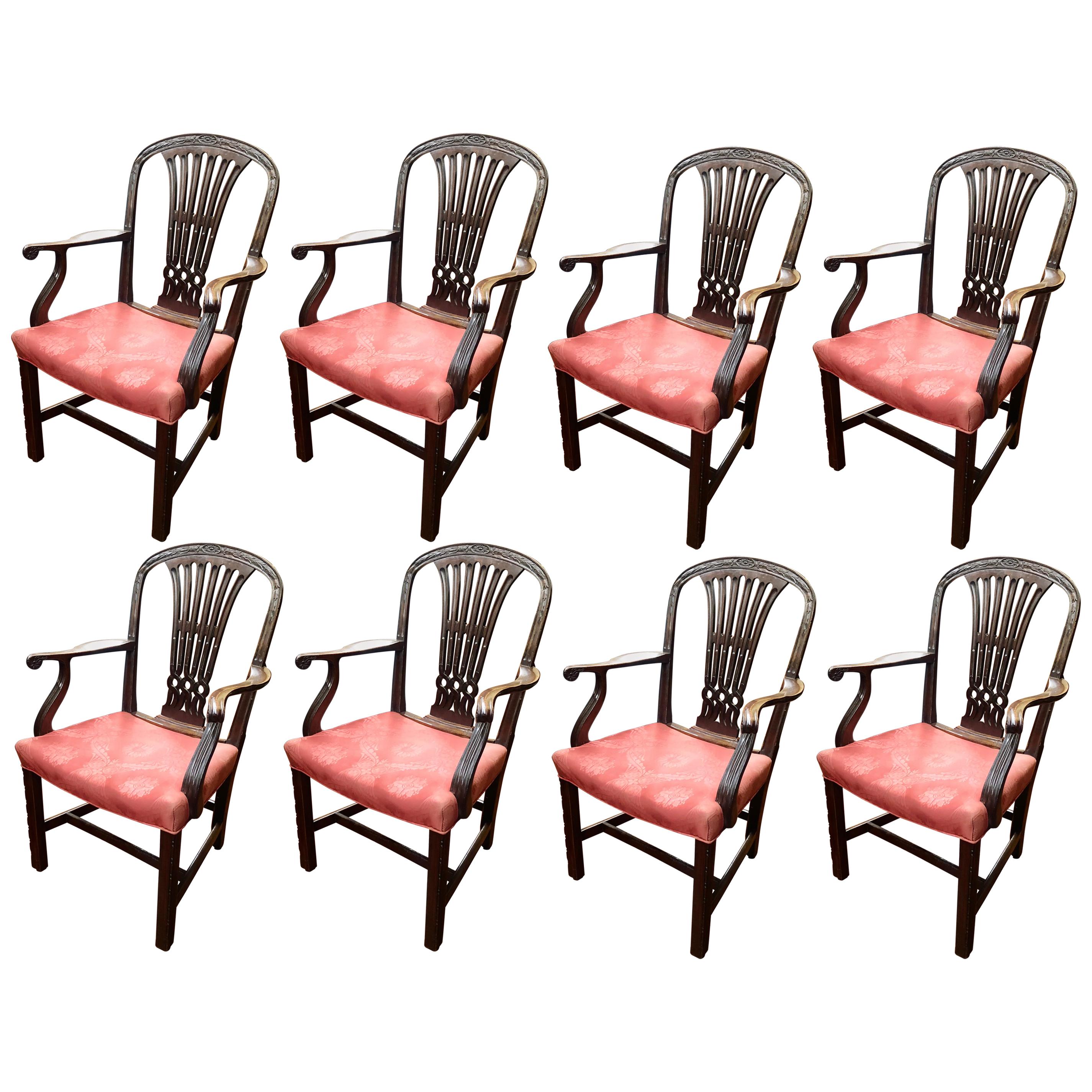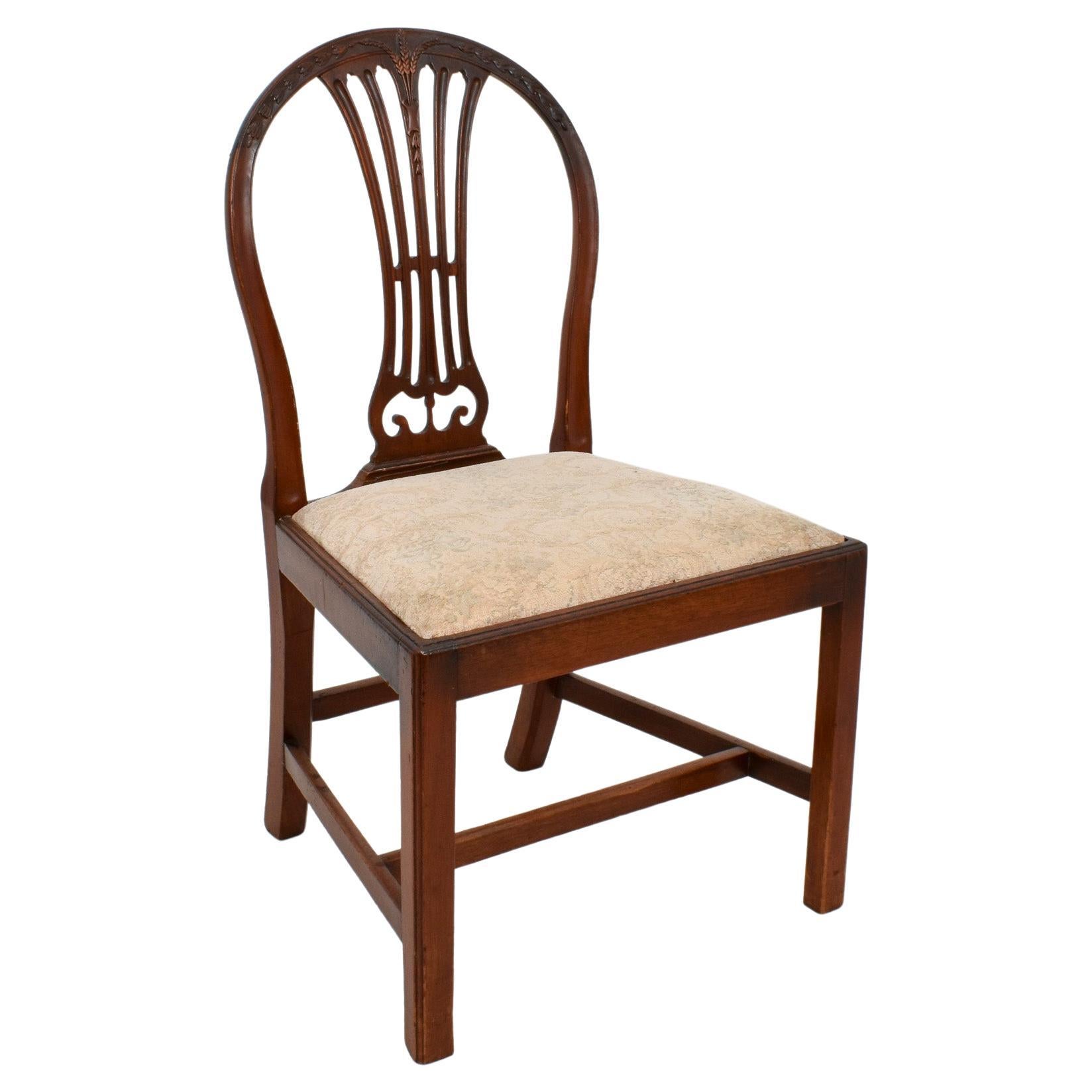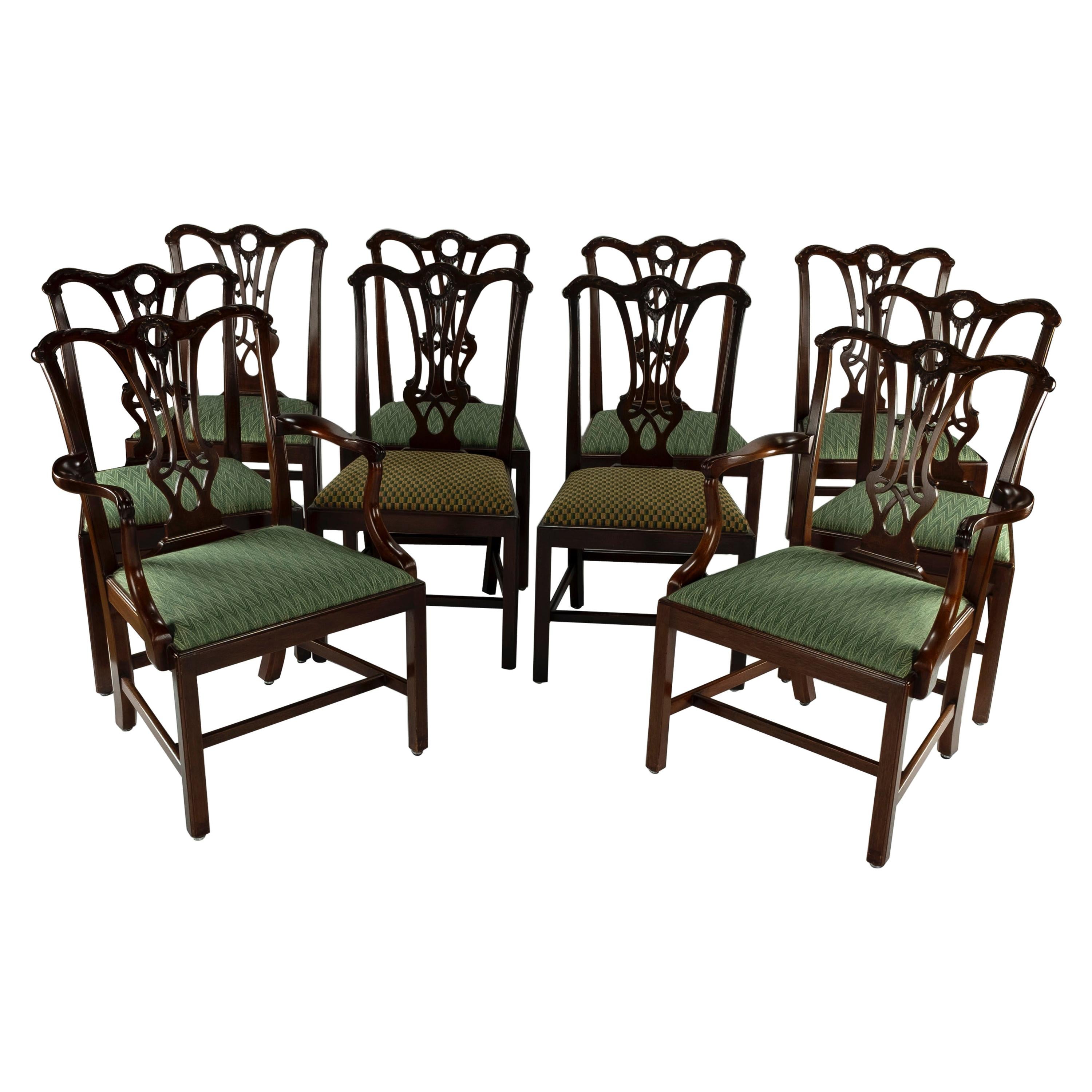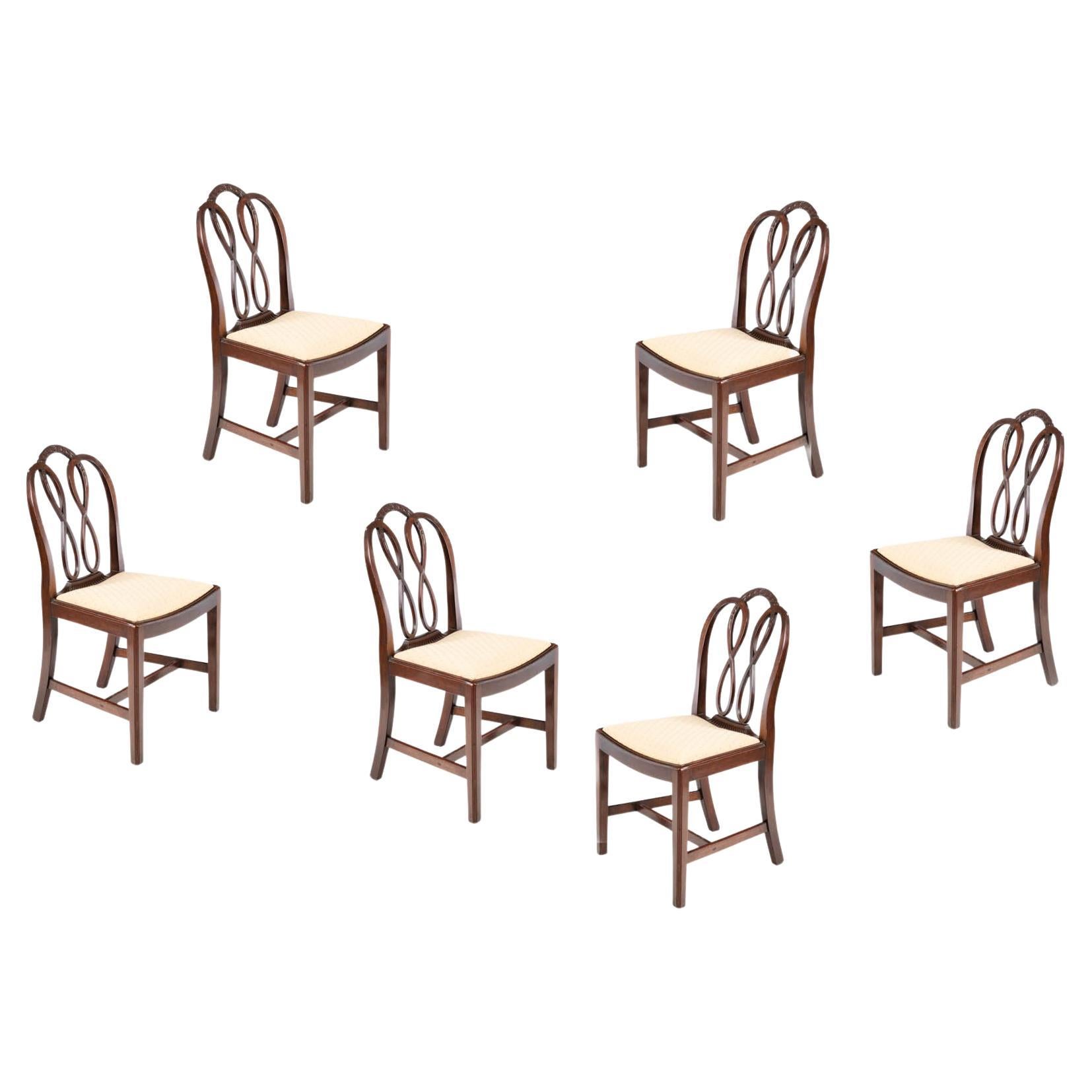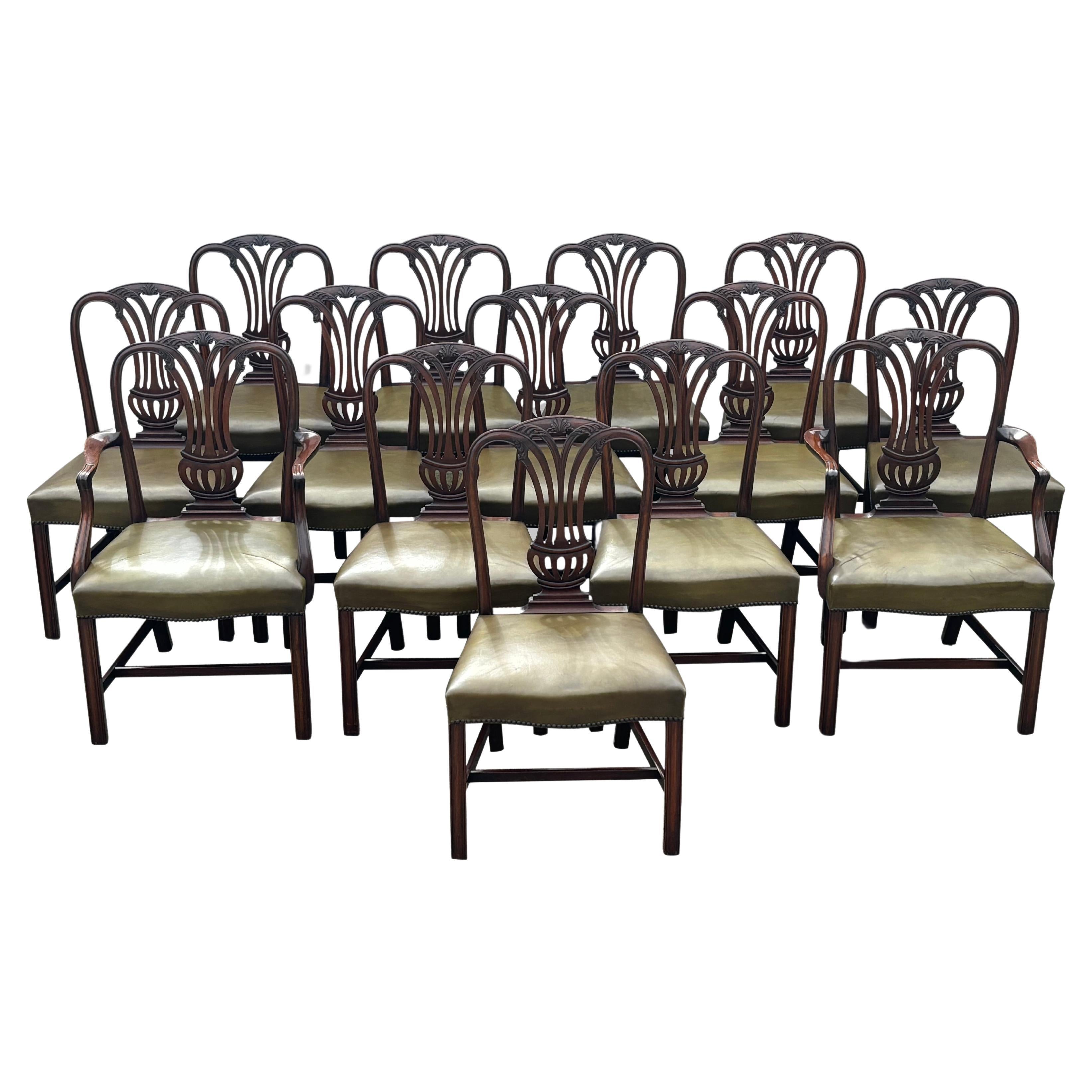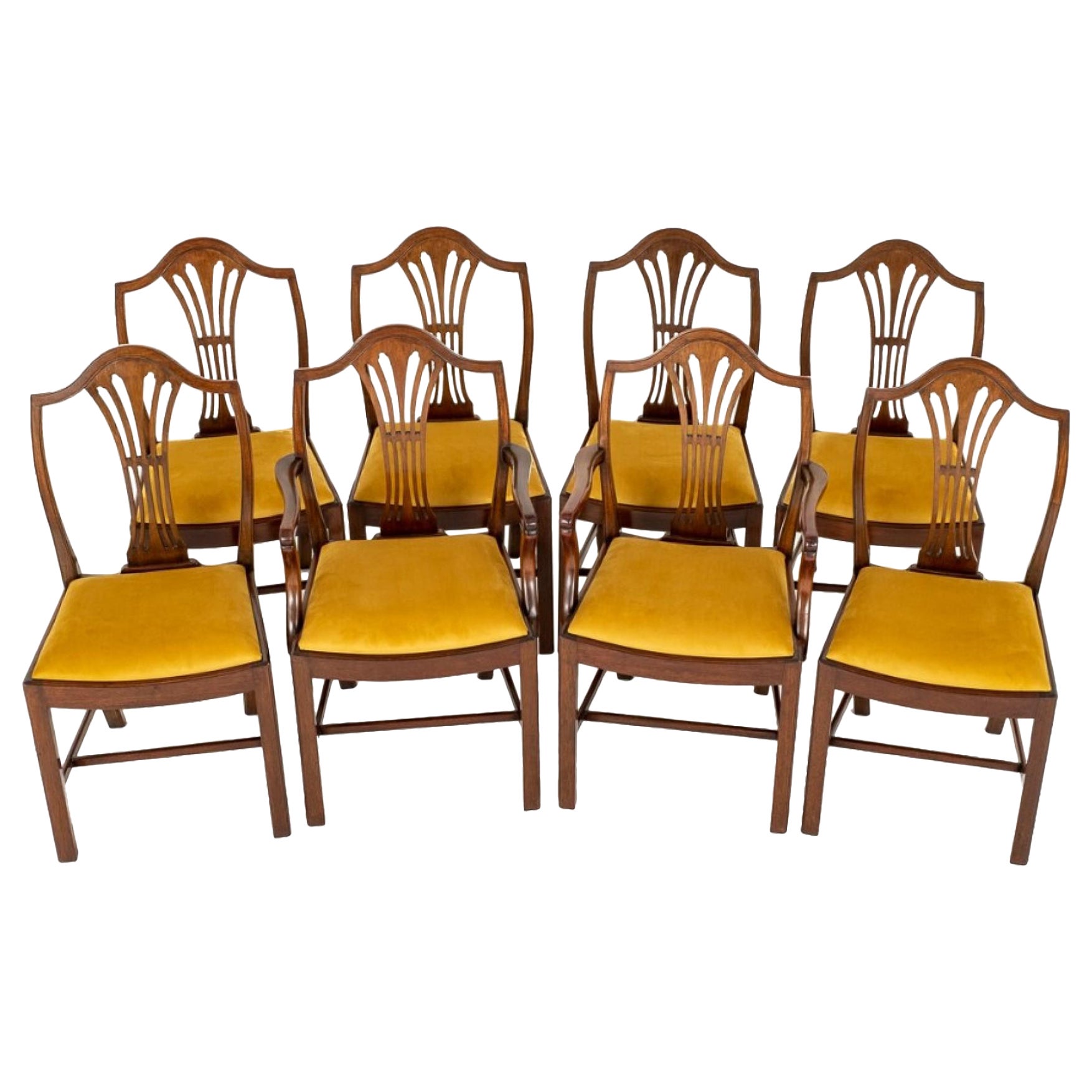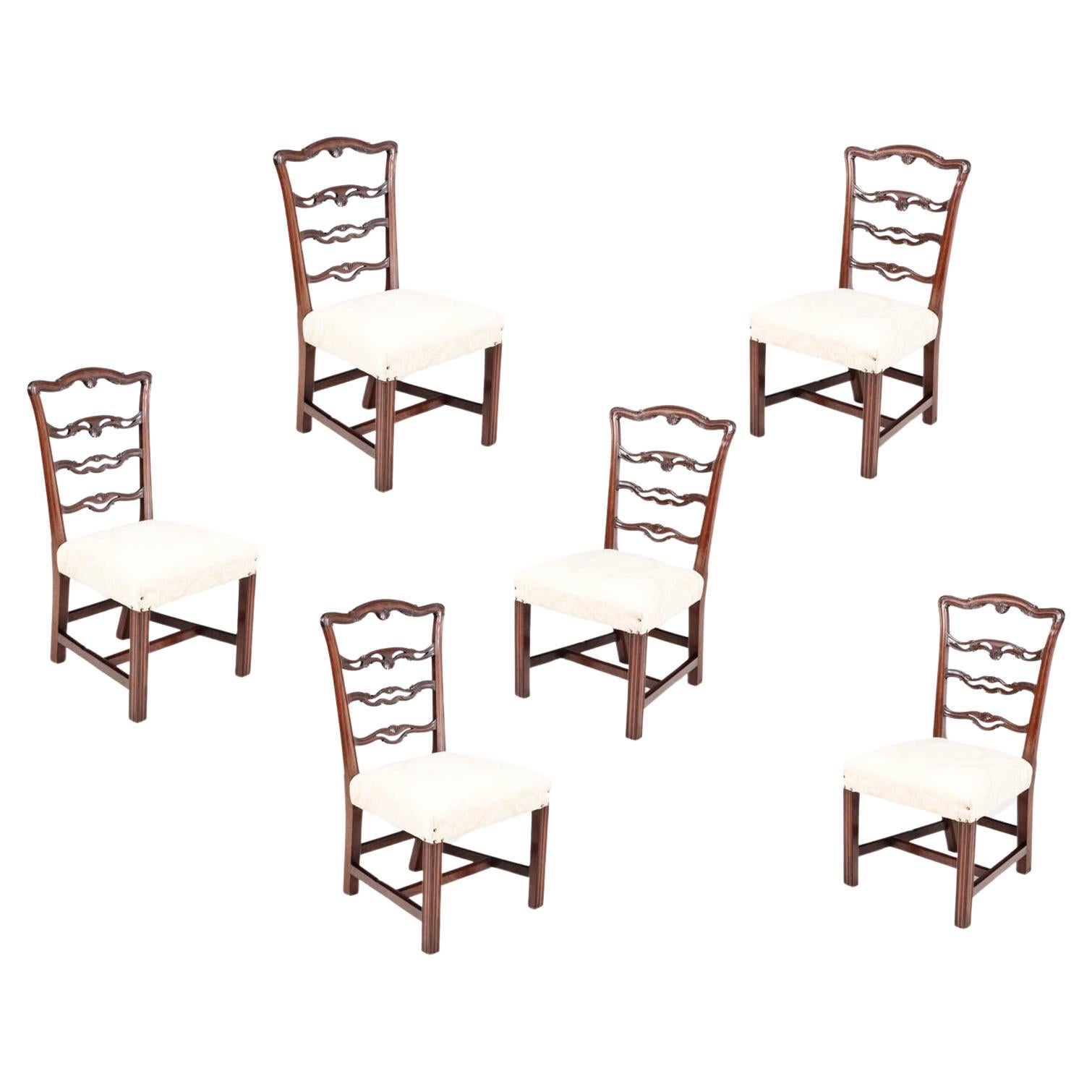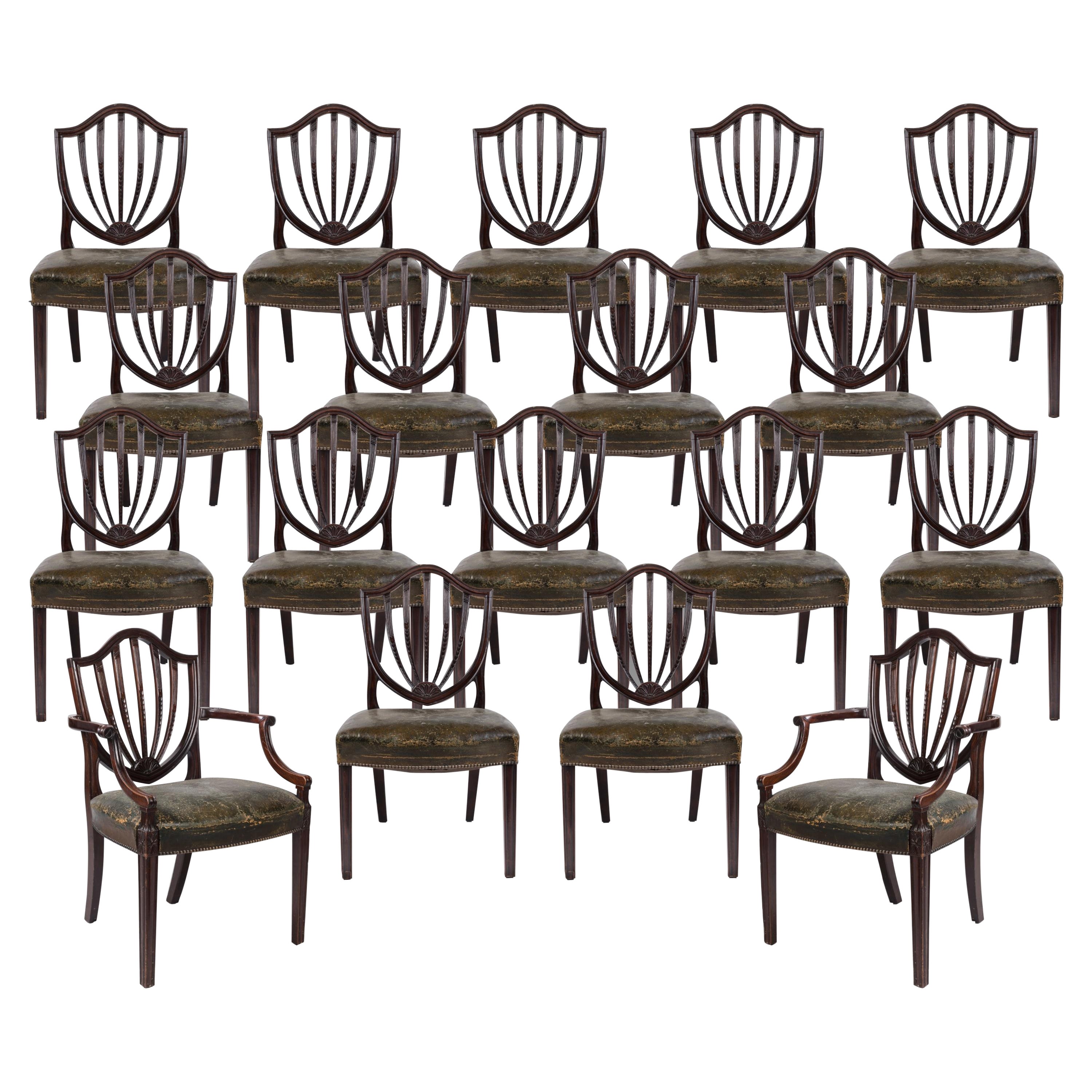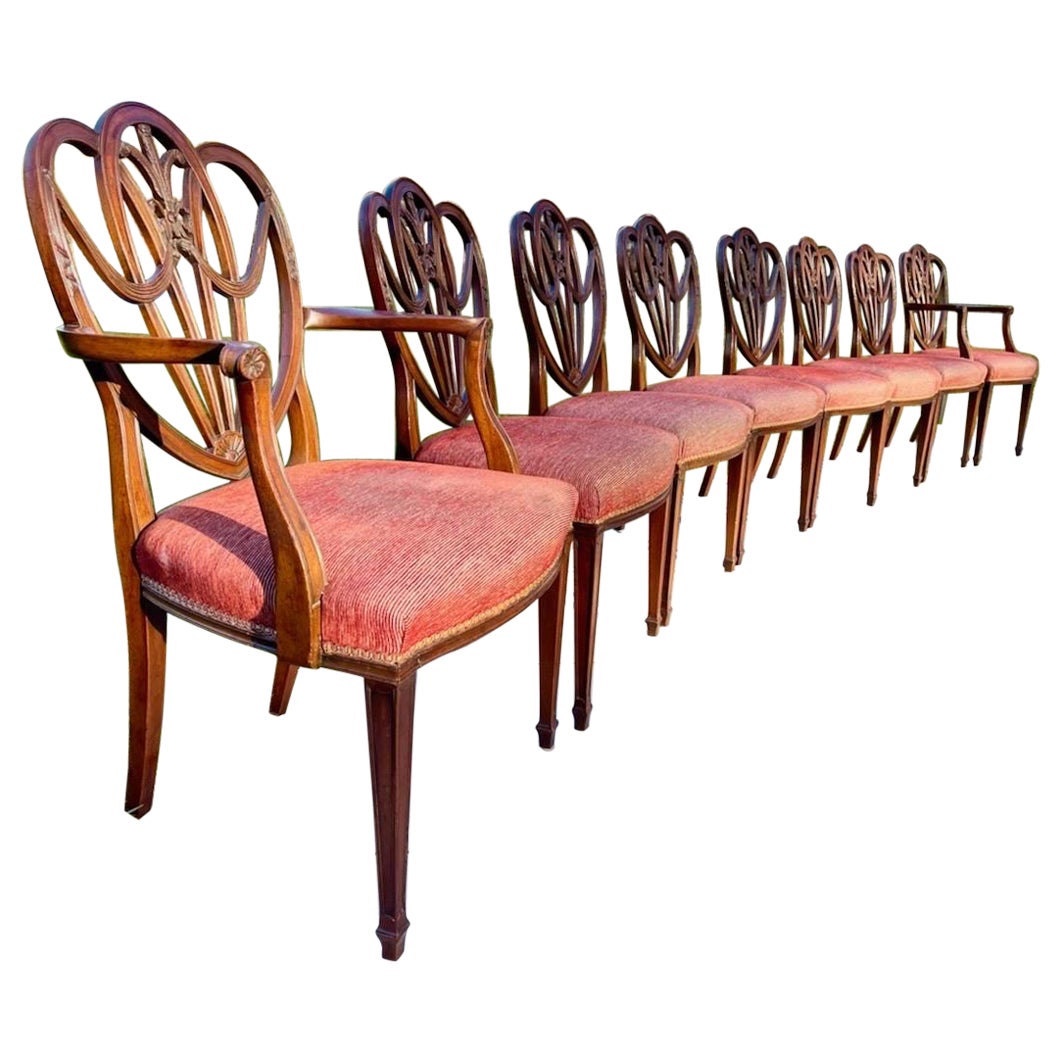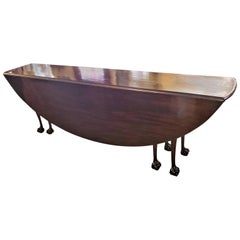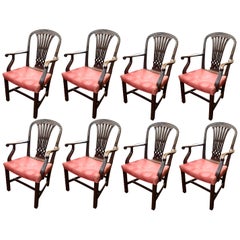
Late 18th Century Mahogany Hepplewhite Style Dining Chairs, Set of 8
View Similar Items
Want more images or videos?
Request additional images or videos from the seller
1 of 13
Late 18th Century Mahogany Hepplewhite Style Dining Chairs, Set of 8
About the Item
- Similar to:George Hepplewhite (Cabinetmaker)
- Dimensions:Height: 38 in (96.52 cm)Width: 22 in (55.88 cm)Depth: 18 in (45.72 cm)Seat Height: 19 in (48.26 cm)
- Style:Regency (Of the Period)
- Materials and Techniques:
- Place of Origin:
- Period:
- Date of Manufacture:1780
- Condition:Wear consistent with age and use. Near Mint. Seats recently re-upholstered.
- Seller Location:Dallas, TX
- Reference Number:1stDibs: LU3978112158583
About the Seller
4.9
Platinum Seller
These expertly vetted sellers are 1stDibs' most experienced sellers and are rated highest by our customers.
Established in 2015
1stDibs seller since 2018
349 sales on 1stDibs
More From This SellerView All
- 19C Set of 6 Irish Chippendale Style Ribbon Back Dining ChairsLocated in Dallas, TXPresenting a fabulous 19C set of 6 Irish Chippendale style ribbon back dining chairs. Irish made circa 1840-60. We know that these are Irish due to the signature ‘hairy paw’ feet which is synonymous with Irish Georgian furniture that were made in the Chippendale Style. These are hand crafted chairs, made of mahogany, and have fabulously detailed ‘Ribbon’ backs splats with tassel, acanthus floral and bow details. All 6 have been re-upholstered by us in a gorgeous tan/light gold silk damask fabric which is beautifully sympathetic to the style and period. We are confident that these are Early to Mid 19th Century chairs for a number of reasons: (1) The are hand crafted, (2) the color/patina is what you would expect with natural aging, (3) they have evidence of historic repairs, wear and tear consistent with age, (4) when we removed the old upholstery fabric, which looked like it was done in the 1980’s, we discovered the original ‘horse hair’ cushion filling … this practice stopped in the early 20th Century. The seat webbing was also much older and needed replacing. Fabulous acanthus carving on the knees of the front legs, with curved legs leading down to the fabulously carved hairy paws. Nice indented decoration on the front of the seat. The rear legs are undecorated and curve outwards for additional support and stability. Unsigned and unmarked but undoubtedly made by a top Irish furniture maker. probably in Dublin. Condition: Each chair has been newly re-upholstered and seat webbing replaced. The original horse hair cushion filling was cleaned and incorporated into the new cushion with modern foam to create a more comfortable and uniform seat cushion, but still retaining originality. Each chair has signs of historic repairs to the ribbon back splats over the generations. This is not unusual due to the somewhat delicate nature of these types of back splats. Also, it is an indicator of true age. The chair to the back left in the main photos has had the most repairs and much more recently performed (by us) as the back splaty was broken in 2 places (but we had the original pieces) and the chair needed the insertion of metal pins to secure the repaired sections. We have provided a couple of photos of this back splat which you can see evidence of the repairs. The repairs are very professionally done and the chair is now fully functionable and usable and the repairs are not very noticeable. These repairs are reflected in the pricing, as, if these chairs were ‘mint’ they would be very valuable and expensive ! Irish furniture can be recognised by certain features, which differentiate it from its European counterparts. The Irish style of furniture is said to have been lagging behind in fashion compared to English equivalent by a number of years, in both its design and manner by which the furniture was manufactured. A defining feature of the mid-eighteenth-century furniture is the carving on different parts of the furniture such as the aprons, blanket chests, bottle-stands and such objects. The carvings included foliated details, baskets of flowers and scallop shells, which are some of the most prominent carvings that are represented on Irish furniture at this time. A few of the Irish makers of these objects were James Hicks, Arthur Jones, William Moore, Mack & Gibton and Robert Strahan. All though individuals would have been the most prominent at the time of the 18th century and early 19th century but there are any other cabinet makers as well. Not all Irish furniture was detailed with such wonderful carvings and some might have been seen to be rather plain. One of the most identifiable items that are described as plain is the Irish Hunt Table, its simple elegance comprising of with straight plain legs. It was most commonly used in the dining room of a rural house such as a agents house or large house of a land holder. Another very popular and simply designed piece was the Irish Silver table, its design is very elegant and yet individual partially owing to the shell motive. Other examples of such Irish tables are side tables which have a distinctive double scrolled leg. Usually legs are carved with acanthus and have paw feet which are quite popular in Ireland but more rare in England. Other features are the inside leg which is carved with elongated C-scroll. The triple scroll on the leg was common place. Some cabinet makers and creativity was really captured with their side tables in how the carving was done. This carving may include Jupiters eagle or Lion mask and flanked Swags of flowers. In other furniture such as chairs, the H-shaped serpentine stretcher was popular in the 18th century in Ireland and when English chairs had moved forward in their design the Irish makers were still using the H-shaped serpentine. There was certainly an overlap between Irish and English furniture, one can see that Irish cabinet makers used English pattern books but used Irish features such as the carvings as the shell, baskets of flowers and foliated details. Another unique feature in Irish cabinet making was Killarney ware...Category
Antique Mid-19th Century Irish Chippendale Dining Room Chairs
MaterialsMahogany
- Set of 6 French Empire Marquetry ChairsLocated in Dallas, TXPresenting an exceptional set of 6 French Empire Marquetry chairs. Made in France circa 1815-20. Set consists of 2 Captains/Carvers and 4 side c...Category
Antique Early 19th Century French Empire Dining Room Chairs
MaterialsBoxwood, Kingwood, Rosewood, Satinwood
$6,600 / set - 18th Century Philadelphia Mahogany Hunt TableLocated in Dallas, TXWe are pleased to present an absolutely stunning and exceptionally rare and high quality early American piece of furniture history! This table was made in the mid-late 18th century circa 1750-1790 (George III/Regency Era), and is made of solid mahogany and sits on 8 legs with exceptionally carved ball and claw feet, unmistakably in the Philadelphia style of 'Ball and Claw' carving and legs. Made of dark Cuban mahogany with secondary woods of either pine or maple. 2 drop leafs on either side supported by swinging gate legs on either side when upwards. Oval in shape and It would comfortably seat 8/10 people. Made in Philadelphia. Gorgeous original patina, dark mahogany with his gloss wax finish. This is a ‘Hunt’ Table and not to be confused with an Irish ‘Wake’ Table...Category
Antique 18th Century American George III Dining Room Tables
MaterialsMaple, Mahogany
- 18th Century British Regency Bureau Chiffonier in Manner of GillowsBy Gillows of Lancaster & LondonLocated in Dallas, TXFantastic piece in impeccable condition. Regency exotic hardwood bureau or secretaire desk or cabinet of lovely proportions. From circa 1790. The top portion consists of an open columned pelmet and shelf with a series of drawers underneath. All made of rosewood. The bottom section is a double door cabinet with double shelving inside. The façade of the doors consist of glorious gilded latticework frames with rose shaped connectors and with brown silk blinds...Category
Antique Late 18th Century English Regency Cabinets
MaterialsRosewood
- 18th Century Dutch Marquetry Silver Table, ExceptionalLocated in Dallas, TXPresenting an absolutely stunning and exceptional 18th century Dutch Marquetry silver table. Made in the Netherlands circa 1780, the silver table is made of walnut and rosewood wi...Category
Antique 18th Century Dutch Regency Side Tables
MaterialsSatinwood, Walnut
- American Hepplewhite Virginian Secretary Chest with Civil War ProvenanceBy George HepplewhiteLocated in Dallas, TXPRESENTING a FANTASTIC and HISTORIC Early 19C American Hepplewhite Virginian Secretary Chest with OUTSTANDING Provenance. This Secretary Chest was made in Virginia in the Early 19th Century, circa 1810. It is made of cherry, walnut and maple and is most definitely in the Hepplewhite Style of the period, with it’s original Hepplewhite brass drawer pulls. IT IS A REALLY INTRIGUING AND HISTORIC PIECE, ESPECIALLY, WHEN VIEWED IN CONTEXT WITH IT”S AMAZING PROVENANCE! This piece was originally owned by Major William Alexander Obenchain who ‘hailed’ from the State of Virginia. He was an engineer and was in the Virginia Corps of Engineers during the Civil War and served on General Robert E. Lee’s staff. It was acquired by him before the Civil War and we believe that this piece was on campaign with him during the War. We know for a fact that he fought at the Richmond Campaign in 1864, as we have, in our Collection, his original Field Map for that Campaign which ended the War. It has remained in family ownership ever since. It has come directly from the Family Estate, together with other VERY IMPORTANT items belonging to Major Obenchain and other IMPORTANT items that belonged to his wife, Eliza Calvert Hall-Obenchain. ALL these items contained in the Collection, are listed/posted individually on our Website. The top drawer is on retractable curved side hinge supports and pulls outwards and drops to reveal a secretary and writing area. The Bureau/Secretary Gallery has 6 drawers and 6 cubbies, a central tabernacle door with another drawer and 2 cubbies and this is flanked by 2 secret pull out compartments. The central tabernacle door has it’s original key and working lock. Closed, it is almost ‘flush’ like the rest of the drawers, with some very minor bowing through age. The 3 drawers underneath are graduated in size and it ends with a serpentine shaped base and sits on four hand carved legs with original metal casters, marked ‘Universal 3’. It has it’s original brasses and hardware throughout, save the addition to 2 contemporary replacement brass hinges to the drop down desk front, as the original hinges were broken, could not be repaired and were not supporting the weight of the drop down leaf. Some minor repairs but not noticeable. Otherwise, the piece is in it’s entirely, ORIGINAL condition! What makes this piece even MORE INTRIGUING and APPEALING HISTORICALLY, are the 2 ‘historic’ circular holes on the piece:- (1) in the back of the piece as seen in the photos. This hole is not symmetrical or fully round and appears to serve no purpose to the piece whatsoever. Sometimes, pieces have holes for wiring for lighting, put in them over the years, but this one never had such lighting or, indeed, any such explanation for this hole, AND (2) the rear hole is replicated, in the corner portion of the bottom drawer and someone (a very long time ago) has used a tin can top, to cover the hole in the back of the drawer. The tin can top is period to the Civil War Era and is embossed “Minimum Volume 1 Pint”. Our conclusion, is that (whilst we are, by no means ballistic experts) that these holes were created by musket balls, fired during one of the Major’s campaigns in the Civil War. It is entirely conceivable that this piece, being strapped into a covered wagon for carriage, would have been on it’s side. We are of the opinion that both holes, were caused or created by a musket ball entered the chest trough the base and back. We also believe that ‘the Major’, used what he had at his disposal on the battlefield, namely, a tin can lid to repair the hole in the drawer. SO THIS PIECE IS A VERY SPECIAL PIECE OF US HISTORY, INDEED! NOT ONLY IS IT AN EARLY 19th CENTURY AMERICAN PIECE, WITH A CONNECTION TO THE STATE OF VIRGINIA, THE CIVIL WAR, HISTORIC & IMPORTANT FIGURES IN THAT WAR AND IMPECCABLE PROVENANCE AND HISTORY! IT IS TRULY UNIQUE! William Alexander Obenchain. Born April 27, 1841 at Buchanan, Botetourt Co., Virginia. Parents: Thomas Jefferson Obenchain and Elizabeth Ann Sweetland. Entered VMI on July 18, 1859 as a member of the VMI (Virginia Military Institute...Category
Antique Early 19th Century American American Classical Historical Memora...
MaterialsBrass
You May Also Like
- Fine Set of 8 Hepplewhite Style Hand Carved Solid Mahogany Dining ChairsBy George HepplewhiteLocated in Charleston, SCSet of 8 (6 sides, 2 armchairs) Hepplewhite style hand carved solid mahogany dining chairs, with rounded crestrail and handsome hand carved and pierced central splat. Superb hand car...Category
Antique Mid-19th Century English Hepplewhite Chairs
MaterialsMahogany
$6,950 Sale Price / set39% Off - 6 Mahogany Hepplewhite Dining Chairs, Circa 1760By George HepplewhiteLocated in Lincoln, GBSet of 6 mahogany Hepplewhite dining chairs with wheat carving to the backs. The wood is beautifully rich and all of the chairs are ...Category
Antique 18th Century Hepplewhite Dining Room Chairs
MaterialsFabric, Mahogany
- Set of Ten 18th Century Mahogany Dining ChairsLocated in Houston, TXSet of ten mahogany dining chairs including two carvers and 8 side chairs. Serpentine crest rail has a pierced splat above a slip sea...Category
Antique Late 18th Century English Chippendale Dining Room Chairs
MaterialsMahogany
$12,000 / set - Early 19th Century Set of Eight Mahogany Hepplewhite-Style Dining ChairsLocated in Dublin 8, IEEarly 19th century set of eight mahogany Hepplewhite-style dining chairs, including two carvers. This set features intricate interlaced back splats complete with delicate floral deta...Category
Antique Early 19th Century Irish Georgian Dining Room Chairs
MaterialsMahogany
- Late 18th-Early 19th Century English Set of 12 Mahogany Dining ChairsLocated in Southampton, NYLate 18th-early 19th century English set of 12 mahogany dining chairs, ten side chairs and two armchairs having brown leather seats w...Category
Antique 19th Century Dining Room Chairs
MaterialsMahogany
- Set of Six Shield Back Wheatsheaf Design Dining Chairs Hepplewhite StyleBy George HepplewhiteLocated in Antwerp, BEThis beautiful set of six reproduction Georges 3 style solid satinwood single dining room chairs features shield backs with central cut wheat...Category
Vintage 1950s English George III Dining Room Chairs
MaterialsSilk, Upholstery, Cherry
Recently Viewed
View AllMore Ways To Browse
Antique 18th Century Dining Chairs
Antique Dining Room Chairs 18th Century
Hepplewhite Dining Set
Hepplewhite Set Of Chairs
Hepplewhite Style Chair
Set Of Hepplewhite Dining Chairs
Mahogany Hepplewhite Dining Chairs
Dining Room Chair Set Hepplewhite
Antique Set Of 8 Mahogany Dining Chairs
6 18th Century Dining Chairs
Upholstered Dining Chairs Set Of 6 8
Antique Hepplewhite Dining Chairs
18th Mahogany Regency Chair
Hepplewhite Style Dining Chairs
Set Of 6 Upholstered Antique Dining Chairs
Silk Upholstered Antique Chairs
6 Regency Style Dining Chairs
Antique Federal Chairs

